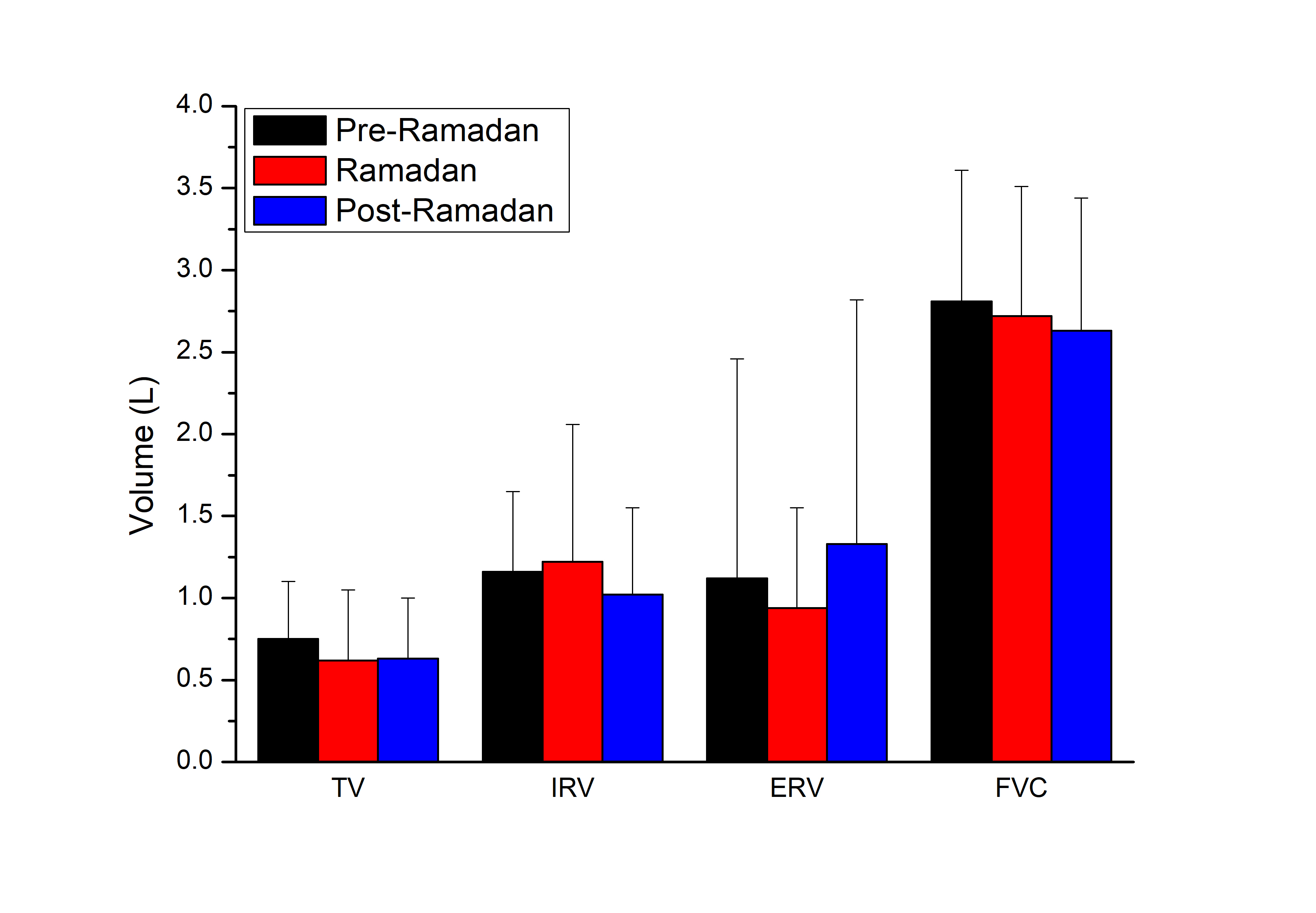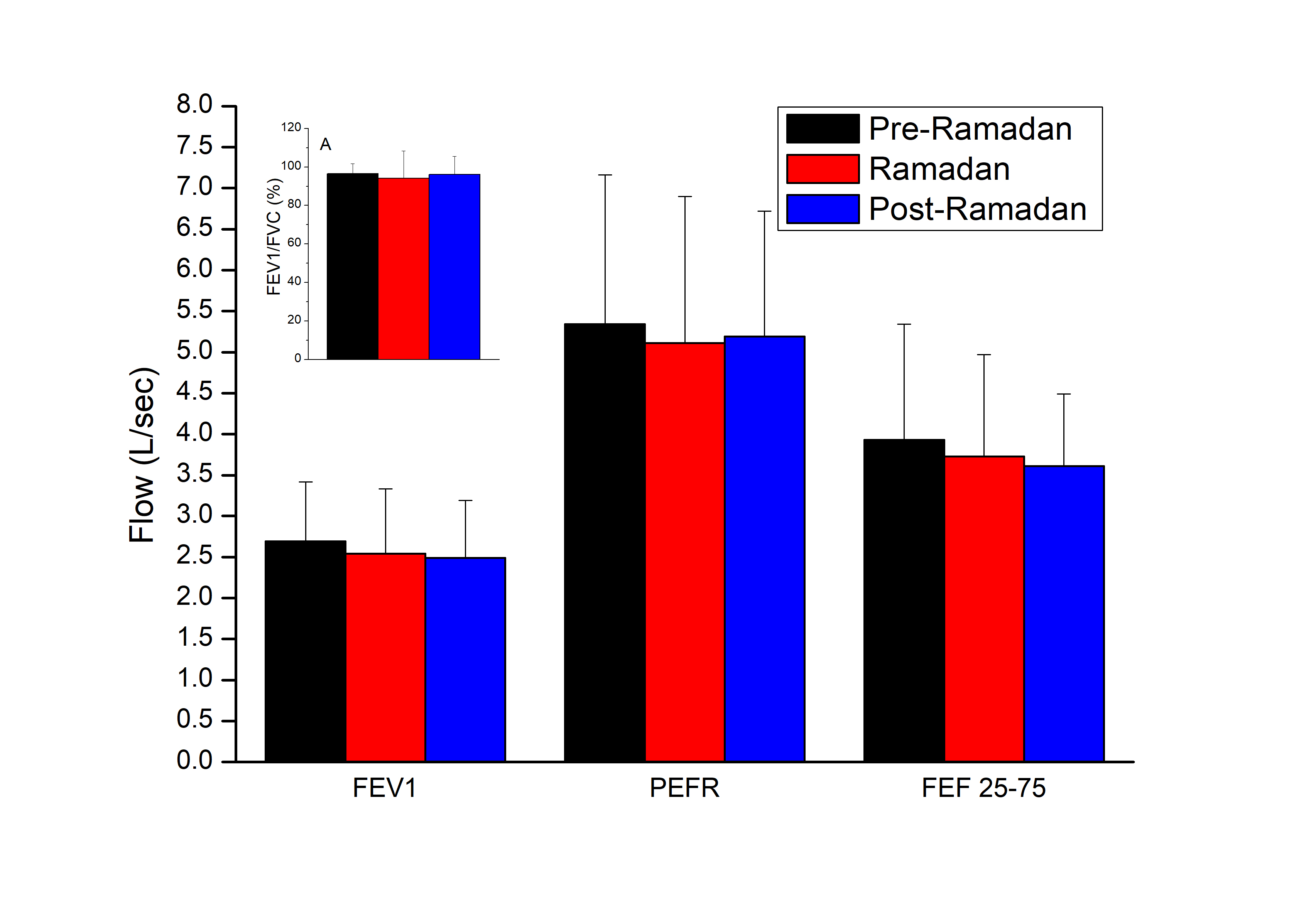Immediate and delayed effect of Ramadan fasting on spirometry parameters
Effects of fasting on lung volumes and capacities
Revised: 2018-02-25
Accepted: 2018-02-27
Online: 2018-03-30
Print: 2018-03-31

Full text
Abstract
Fasting in the month of Ramadan is an obligatory duty for muslims. Researchers have investigated health benefits of fasting and reported conflicting results. The purpose of this study was to determine the immediate and delayed effects of Ramadan fasting on spirometric parameters. 50 apparently healthy young adults aged between 17-27 years, belonging to both genders who fast during the month of Ramadan were enrolled for the study. Spirometric recordings were done at three different time points. First: 5-10 days before the start of Ramadan (Pre-Ramadan); second: within 10 days of the beginning of Ramadan fasting (Ramadan); third: within 7 days of the end of Ramadan (Post-Ramadan). There were no statistically significant differences between the three phases with respect to tidal volume (TV), inspiratory reserve volume (IRV), expiratory reserve volume (ERV), forced vital capacity (FVC), forced expiratory volume in 1 sec (FEV1), FEV1/FVC, peak expiratory flow rate (PEFR) and forced expiratory flow 25% to 75% (FEF25-27). To conclude, Ramadan fasting does not have any significant effect on pulmonary function tests as assessed by spirometry. Hence, the diagnosis and prognosis of a respiratory disorder made on spirometry findings are reliable and need no error correction if an individual is fasting.
Keywords
Fasting, FEV1, FVC, MVV, PEFR, Pulmonary function tests, Ramadan, Spirometry
Introduction
According to Hijri calendar, which follows lunar cycles, Ramadan is the 9th month during which muslims fast. Duration of fasting (just before dawn till the sunset) varies according to the season and ranges between 11 to 14 hours in India. Holy Scripture and tradition (Quran and Hadith) mentions the spiritual and health benefits of fasting. In this era of evidence-based medicine, researchers have attempted to find and establish the benefits of Ramadan fasting. Studies carried out described physical, emotional and spiritual benefits and few studies concluded no advantage [1]. Ramadan fasting has beneficial effect on host immune system especially against chronic infection like tuberculosis [2]. An Indian study reported changes in aerobic fitness parameters like agility, VO2 Max and high-intensity efforts (HIE) due to Ramadan intermittent fasting [3]. An Egyptian study showed that none of the pulmonary function test (PFT) and arterial blood gas (ABG) analysis parameters changed significantly during fasting [4].
The purpose of this study was to determine the immediate and delayed effects of Ramadan fasting on spirometric parameters.
Materials and Methods
Study was carried out after approval from the Institutional Review Board (IRB) (IRB No. 2016/11/010) in the Department of Physiology of our college between May and June 2016.
50 apparently healthy young adults aged between 17-27 years, belonging to both genders, who fasted during the month of Ramadan, engaged in more or less similar physical activity during fasting as carried out before Ramadan were recruited in this study. Informed consent was obtained from all participants.
Smokers, those with restrictive or obstructive respiratory disease, acute of chronic upper or lower respiratory tract infection/inflammation, trauma to chest, tender lesions of chest were excluded.
Spirometric recordings were done at three different time points. First: 5-10 days before the start of Ramadan (Pre-Ramadan); second: within 10 days of the beginning of Ramadan fasting (Ramadan) to document the immediate effects; third: within 7 days of the end of Ramadan (Post-Ramadan) to document the delayed effects.
Spirometry was performed using computer based spirometer—MedSpiror (Recorders and Medicare Systems Pvt. Ltd., Chandigarh, India.). Parameters were recorded in standing posture, with subject holding the flow-hood in right hand and nose clip applied. Forced respiratory parameters were performed for a very short duration. Any complaints of dizziness while performing the task, the procedure was to be aborted.
Following parameters were documented: tidal volume (TV), inspiratory reserve volume (IRV), expiratory reserve volume (ERV), forced vital capacity (FVC), forced expiratory volume in 1 sec (FEV1), FEV1/FVC, peak expiratory flow rate (PEFR) and forced expiratory flow 25% to 75% (FEF25-75).
Statistical analysis
Data obtained was subjected to repeated measures ANOVA. The p value <0.05 was considered statistically significant.
Results
The data is presented as Mean±SD for scale variables and number(%) for categorical variables. Table 1 shows the demographic and anthropometric data of the study participants. A total of 50 young healthy volunteers were recruited for the study. One participant was excluded from the analysis because of missing data, therefore data of only 49 participants were analyzed.
| Parameter | Value |
|---|---|
| Age (in years) | 19.49±1.02 |
| Gender | |
| Male | 22 (44.9%) |
| Female | 27 (55.1%) |
| Weight (in Kg) | 63.67±15.51 |
| Height (in cm) | 165.50±10.42 |
| BMI (in Kg/m2) | 23.09±4.38 |
One way repeated measures ANOVA was carried out with gender as between-subjects variable whereas weight and height as covariates. Depending on the significance value of Mauchly’s test of sphericity, the differences in the main effects are reported with appropriate correction applied (p>0.05, no correction; p<0.05, then correction depends on ε value; ε<0.75, Greenhouse-Geisser correction; ε>0.75, Huynh-Feldt correction).
| Parameter | Gender | Pre-Ramadan | Ramadan | Post-Ramadan | F(df,error), p |
|---|---|---|---|---|---|
| TV (L) | Male | 0.89±0.36 | 0.57±0.35 | 0.73±0.46 | |
| Female | 0.65±0.31 | 0.66±0.50 | 0.54±0.26 | ||
| Total | 0.75±0.35 | 0.62±0.43 | 0.63±0.37 | 0.154(2,90), 0.858 | |
| IRV (L) | Male | 1.40±0.52 | 1.60±1.03 | 1.19±0.68 | |
| Female | 0.96±0.36 | 0.90±0.47 | 0.88±0.33 | ||
| Total | 1.16±0.49 | 1.22±0.84 | 1.02±0.53 | 0.060(1.444,64.965), 0.889 | |
| ERV (L) | Male | 1.48±1.63 | 0.99±0.62 | 1.51±1.67 | |
| Female | 0.83±0.99 | 0.90±0.60 | 1.18±1.33 | ||
| Total | 1.12±1.34 | 0.94±0.61 | 1.33±1.49 | 0.268(1.940,87.278), 0.759 | |
| FVC (L) | Male | 3.44±0.65 | 3.31±0.54 | 3.04±0.96 | |
| Female | 2.30±0.48 | 2.24±0.63 | 2.28±0.46 | ||
| Total | 2.81±0.80 | 2.72±0.79 | 2.63±0.81 | 3.935(2,90), 0.023* | |
| FEV1 (L/sec) | Male | 3.24±0.62 | 3.12±0.50 | 2.79±0.86 | |
| Female | 2.25±0.45 | 2.07±0.67 | 2.24±0.42 | ||
| Total | 2.69±0.73 | 2.54±0.79 | 2.49±0.70 | 4.072(2,90), 0.020* | |
| FEV1/FVC (%) | Male | 94.73±6.56 | 94.79±7.14 | 93.36±13.47 | |
| Female | 97.86±3.25 | 93.53±18.31 | 98.39±2.66 | ||
| Total | 96.45±5.20 | 94.09±14.29 | 96.13±9.47 | 0.111(1.776,79.904), 0.873 | |
| PEFR (L/sec) | Male | 6.31±2.14 | 6.17±1.93 | 5.92±1.71 | |
| Female | 4.56±0.99 | 4.25±1.09 | 4.60±1.07 | ||
| Total | 5.34±1.82 | 5.11±1.79 | 5.19±1.53 | 1.304(2,90), 0.277 | |
| FEF 25-75 (L/sec) | Male | 4.47±1.74 | 4.36±1.44 | 3.92±0.96 | |
| Female | 3.48±0.90 | 3.21±0.74 | 3.36±0.74 | ||
| Total | 3.93±1.41 | 3.73±1.24 | 3.61±0.88 | 3.537(2,90), 0.033* |
Table 2 shows that among the static spirometry parameters (Figure 1) only FVC and among dynamic spirometry parameters (Figure 2) FEV1 and FEF 25-75 seems to differ statistically between the 3 phases but the post hoc multiple comparison tests for these parameters did not reveal any statistical significance.


Discussion
Effects on respiratory system have been studied by various authors with different study designs. An Egyptian study showed that none of the pulmonary function test (PFT) and arterial blood gas (ABG) analysis parameters changed significantly during fasting [4]. Siddiqui et al showed that there was no change in forced respiratory parameters (FVC, FEV1, FEV1/FVC, MVV, PEFR, FEF25-75) during Ramadan fasting compared to pre-Ramadan baseline values [5]. Latiri et al [6] concluded that Ramadan fasting did not bring about any significant changes in the spirometric values. Our study was is consonance to the above studies wherein no statistically significant difference was noted. A Malaysian study also reported similar findings except for FEF which was significantly decreased during Ramadan [7]. An Asian study by Subhan et al showed that there is an increase in FEF75 and FEF75-85 and attributed to decrease in body mass and body fat as a consequence of fasting [8]. Moosavi et al [9] reported increase in FVC, FEV1, PEFR during Ramadan but attributed these changes to decrease in body weight due to fasting.
Studies carried out on asthmatics showed that there are no significant difference in severity, number of hospitalization and the spirometric values (FVC, FEV1, FEF25-75, FEV1/FVC, PEFR) while fasting during the month of Ramadan when compared to the non-fasting months [10, 11]. Other study by Amini et al on asthmatics reported similar findings except for PEFR which improved during fasting [12]. Askari et al concluded that Ramadan fasting may have some positive effect on asthma severity [13].
Acknowledgments
None
References
- Leiper JB, Molla AM, Molla AM. Effects on health of fluid restriction during fasting in Ramadan. Eur J Clin Nutr. 2003 Dec; 57 Suppl 2:S30-8. [Pubmed] [Crossref]
- Lahdimawan A, Handono K, Indra MR, Prawiro SR. Effect of Ramadan fasting on the ability of serum, PBMC and macrophages from healthy subjects to kill M. tuberculosis. IOSR Journal of Pharmacy and Biological Sciences (IOSR-JPBS) 2014; 9(1):24-9. [Crossref]
- Roy AS, Bandyopadhyay A. Ramadan intermittent fasting on selective fitness profile parameters in young untrained Muslim men. BMJ Open Sport Exerc Med 2015 Sep 30; 1(1):e000020. [Pubmed] [Crossref]
- Abdel-aziz EA, Ibraheem AS. Fasting during Ramadan: does it alter pulmonary functions in healthy males? Al-Azhar Assiut Med J. 2008 Sep; 6(3):52-63.
- Siddiqui QA, Sabir S, Subhan MM. The effect of Ramadan fasting on spirometry in healthy subjects. Respirology. 2005 Sep; 10(4):525-8. [Pubmed] [Crossref]
- Latiri I, Sandid S, Fennani MA, Hadrich M, Masmoudi T, Maatoug C, Zammit-Chatti M, Chamari K, Ben Saad H. The effects of ramadan fasting on the spirometric data of healthy adult males. Am J Mens Health. 2017 Jul; 11(4):1214-23. [Pubmed] [Crossref]
- Duncan MT, Husain R, Raman A, Cheah SH, Ch'ng SL. Ventilatory function in Malay Muslims during normal activity and the Ramadan fast. Singapore Med J. 1990 Dec; 31(6):543-7. [Pubmed]
- Subhan MM, Siddiqui QA, Khan MN, Sabir S. Does Ramadan fasting affect expiratory flow rates in healthy subjects? Saudi Med J. 2006 Nov; 27(11):1656-60. [Pubmed]
- Moosavi SA, Kabir A, Moghimi A, Chehrei A, Rad MB. Evaluation of the effect of Islamic fasting on lung volumes and capacities in the healthy persons. Saudi Med J. 2007 Nov; 28(11):1666-70. [Pubmed]
- Bener A, Colakoglu B, Mobayed H, El Hakeem A, Al Mulla AA, Sabbah A. Does hospitalization for asthma and allergic diseases occur more frequently in Ramadan fasting: a population based study (2000-2004). Eur Ann Allergy Clin Immunol. 2006 Apr; 38(4):109-12. [Pubmed]
- Adeli SH, Aghaali M, Nasab JM. Studying the effects of fasting during Ramadan on pulmonary function test and asthma severity. Health, Spirituality and Medical Ethics. 2015 Spring; 2(1):2-5.
- Amini M, Attaran D, Norouzy SA, Karimirad R, Baygi ZS, Mohajeri MR, Mohajeri SA, Nematy M. Effects of Ramadan fasting on spirometric values and clinical symptoms in asthmatic patients. J Fasting Health. 2013; 1(1):23‐7.
- Askari VR, Alavinezhad A, Boskabady MH. The impact of "Ramadan fasting period" on total and differential white blood cells, haematological indices, inflammatory biomarker, respiratory symptoms and pulmonary function tests of healthy and asthmatic patients. Allergol Immunopathol (Madr). 2016 Jul-Aug; 44(4):359-67. [Pubmed] [Crossref]

